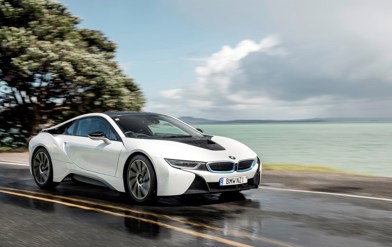There’s generally a strong line of demarcation between Land Rover 4x4 and Jaguar SUV products. But the exception is the Range Rover Velar, which is the most road-oriented of the Land Rover lineup because it’s based on the platform of the Jaguar F-Pace (while still being generally excellent in the rough regardless).
So where there’s an F-Pace Plug-in Hybrid Vehicle (PHEV), the Velar can follow. Jaguar introduced the P400e powertrain in its revised F-Pace lineup last year, and now the same setup is available in the Velar.

The Velar PHEV matches a 2.0-litre turbo-petrol four-cylinder engine with a relatively large 17kWh plug-in battery pack, giving a claimed 53km of pure-electric running – with the battery boost enabling impressive 0-100km/h performance of 5.4 seconds in hybrid mode when required. That’s the genius of dual-purpose PHEV technology.
On paper, it’s a tempting package. Our test car looks swish thanks to a couple of options like a black exterior package and 20-inch alloys, but it’s actually the entry SE model. By no means cheap at $139k, but still $10k less than the base Jaguar F-Pace P400e, which starts at $149,900. You can have an HSE version of the Velar for the same money, but honestly – the SE is pretty luxurious as it is. The HSE adds trinkets like more power adjustment for the steering wheel and seats, cooled chairs up front and imposing 21-inch wheels, but on the whole you don’t feel like you’re missing much with the SE.
There are two ways to look at the Velar P400e. The first is as a short-range EV. Land Rover has been quite clever in giving its plug-in system DC fast-charging capability (like a Battery Electric Vehicle uses and still relatively rare for a PHEV); so while you’ll probably still charge overnight at home most of the time, when you have the opportunity you can also use a public DC station and recharge at a rate of up to 32kW per hour. The Velar sports a CCS port (like a BEV) for this purpose.
To view all Range Rover models listed on DRIVEN, click here
In overly simplified terms, at max charge rate you can theoretically get the Velar battery close to “full” again in 30 minutes (although the actual speed depends on a number of things that the car and terminal will work out between them).

Given the price of petrol, even at an indicative recharging cost of 25c per kWh/25c per minute to park (about $10 for 50km), it still makes sense to charge at a paid public station if it’s convenient. But remember there are also still many free DC outlets in NZ cities at the moment and a lot of 22kW AC stations at shopping centres; and nothing’s better than free running.
A silent Range Rover is superb for city use and the P400e still has plenty of power to keep pace with urban traffic, although it will kick into hybrid mode if you put your foot right down. You can select Hybrid, EV or Save (where it keeps the current state of battery charge) via the rather striking centre-console touch screen. You switch between drive modes in the same place, but the screen and physical controls can also reconfigure themselves to be the climate centre – a clever touch (pun intended) introduced on Velar but since carried over to other Jaguar Land Rover (JLR) models, including the I-Pace.

The other way to look at the Velar P400e is as a hybrid. It’s much less happy in city driving in petrol-electric mode, with sometimes-staccato low-speed acceleration as it dithers between momentary pure-electric (which is still available even when the battery is theoretically flat) and full hybrid operation.
Ideally you won’t be suffering that, as the concept of a PHEV is that you drive in pure-electric around town and save the hybrid stuff for longer journeys; but it is annoying.
On the open road, the Velar is brilliant. A hint of gruffness from the four-cylinder engine under load, but in brisk driving the powertrain is smooth and commendably quick. It’s fast to 100km/h like we said, but we also managed 5.9l/100km on a 200km Saturday afternoon road trip that commenced with the battery depleted – admittedly mostly on motorways at smooth 100km/h, but still pretty impressive for a 2.2-tonne luxury SUV that was running on adaptive cruise control most of the time.

And it is very luxurious. Exterior style is the main drawcard of the Velar in Range Rover world, but inside it’s also a real feel-good proposition, with dark tones and lots of leather.
The upgrade to JLR’s new Pivi Pro infotainment system is welcome because the previous setup was slow and a bit glitchy; this one’s generally smooth and quick, although the wireless CarPlay did have its moments and a couple of crashes (oddly, the identical system in the I-Pace we tested the week previous was faultless).
Land Rover still offers conventional petrol and diesel Velar models, so is there a real case for the P400e? In an increasingly electrified age, the P400e certainly makes sense from a futureproofing/residual value point of view, and although you won’t get a Clean Car Discount you’ll also avoid a fine thanks to that 68g/km CO2 figure.

The P400e doesn’t have the powertrain character of the same-price Velar D300 six-cylinder turbo-diesel, but the PHEV is also over a second quicker to 100km/h and a lot more efficient. Just keep that battery pack charged up for city driving.
RANGE ROVER VELAR P400e R-DYNAMIC SE
ENGINE: 2.0-litre turbo-petrol engine with 17kWh plug-in battery
POWER: 297kW/640Nm
GEARBOX: 8-speed automatic, AWD
0-100KM/H: 5.4 seconds
CONSUMPTION: 2.2-2.6l/100km, EV range 53-46km, CO2 68g/km (WLTP)
PRICE: $139,000













